How are 2023 Women’s World Cup groups decided if teams finish level on points?
- For the first time in Women's World Cup history, the first round consists of eight groups of four teams
- If two or more nations are level on points at the end of the group stage, there are numerous tiebreakers, starting with goal difference
- The drawing of lots is a last resort

For the first time in the all-too short history of the official Women's World Cup, as many as 32 teams are involved in the group stage.
When the powers that be at FIFA eventually saw fit to sanction a global footballing tournament for women in 1991, only 12 nations took part in matches that were just 80 minutes long.
A lot has changed over the subsequent three decades. Most notably, the gap in quality between countries from every association has dramatically shrunk based on the slew of razor-tight contests during the opening rounds of the 2023 World Cup.
With margins of victory smaller than ever, this may not only be the largest group stage in Women's World Cup history, but the closest.
Here's everything you need to know about how teams will be ranked in the group stage if they cannot be separated by points.
How many teams advance from each group in the 2023 Women's World Cup?
The first stage of the World Cup finals consists of a mini round-robin tournament. The 32 nations are split into eight groups of four - based on world rankings from October 2022 - and play each team in their section. Just like league competition, three points are awarded for a win, one for a draw and none in the event of a defeat.
At the end of the group stage, which is scheduled to conclude on Thursday 3 August, half of the draw goes home as only the two highest-ranked teams advance to the knockout stage.
Teams are firstly ranked by points won. After that, it gets a little more complicated.
READ MORE ON THE WOMEN'S WORLD CUP IN AUSTRALIA & NEW ZEALAND
feed
How are 2023 Women’s World Cup groups decided if teams finish level on points?
In the entirely likely event that two or more teams from the same group finish level on points after all three first-round games, the primary tiebreaker is goal difference. This is the simple calculation of the number of goals scored minus the number of goals conceded by one side across the entire group phase. The team with the higher figure comes out on top.
If all sides involved have an equal goal difference, the team with the higher number of total goals scored nudges ahead.
When total group stage figures can't separate two or more nations, the focus turns towards the specific encounters between the countries. The sides in question are first ranked by the number of points won from matches between the nations concerned. If there is still nothing to separate them, the team with the superior goal difference from the head-to-head games advances before goals scored in this sequence of matches is examined.
Should the nations in question remain entangled even after their head-to-head records are scrutinised, officials will have to dust off FIFA's 'Fair Play' criteria.
During their final group game of the 2018 men's World Cup, Japan's coaching staff realised that their position in Group H would be decided by Fair Play points. Trailing 1-0 to already-eliminated Poland, manager Akira Nishino instructed his players not to search for an equaliser but avoid another yellow card at all costs. Senegal lost to Colombia by the same scoreline and bowed out by virtue of an inferior disciplinary record. The coach Aliou Cisse admitted: "It was very hard to digest."
FIFA Fair Play criteria
Indiscretion | Penalty |
|---|---|
Yellow card | -1 point |
Indirect red card | -3 points |
Direct red card | -4 points |
Yellow card and direct red card | -5 points |
Each disciplinary indiscretion carries a punishment as listed above. At the end of the group stage, each player's contribution is tallied up and the nation with the fewest penalties comes out on top if it comes to such a comparison.
The final tiebreaker to decide the superior side between multiple nations that cannot be separated by any logical criteria is dictated by sheer luck; the drawing of lots.
2023 Women's World Cup tiebreakers
Rank | Tiebreaker |
|---|---|
1 | Total points |
2 | Total goal difference |
3 | Total goals scored |
4 | Head-to-head points |
5 | Head-to-head goal difference |
6 | Head-to-head goals scored |
7 | Fair Play points |
8 | Drawing of lots |
LISTEN NOW
Former Italy international Arianna Criscione, Dulwich Hamlet's Brittany Saylor and Football for Future founder Elliot Arthur-Worsop join Katie Cross to have football's climate conversation about the Women's World Cup and tournament football's carbon footprint. Pledgeball's Heather Ashworth also gives an update on the Pledgeball's new Women's World Cup initiative.
If you can't see this embed, click here to listen to the podcast!